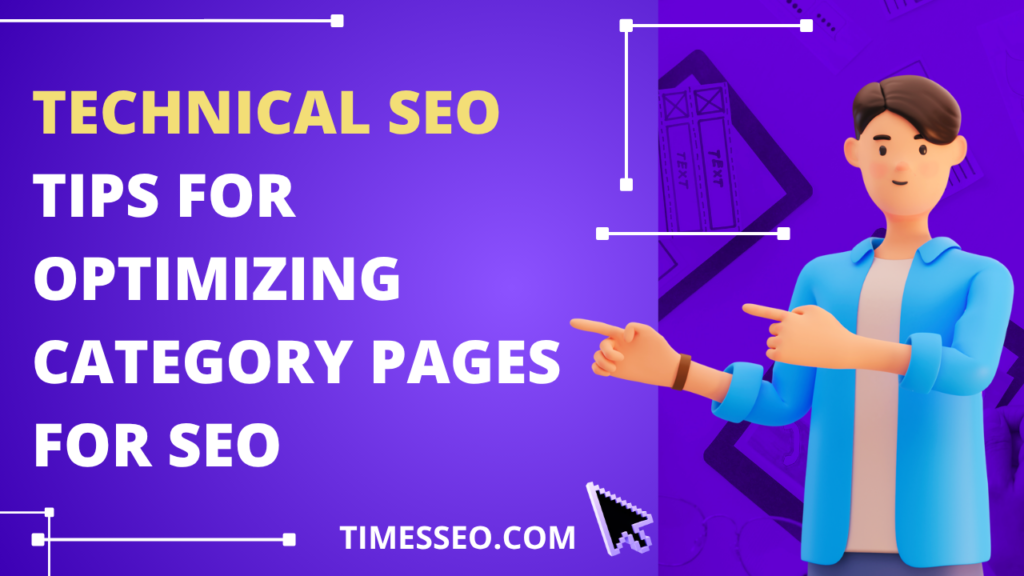
Technical SEO Tips for Optimizing Category Pages for SEO
Unlock the power of optimizing category pages for SEO with these essential technical SEO tips. This blog post dives into best practices like improving crawlability, enhancing page speed, using structured data, and fixing duplicate content issues—ensuring your category pages rank higher and perform better in search engines. A must-read guide for e-commerce and content-heavy websites.
Table of Contents
Introduction
Let’s face it—category pages are often treated like second-class citizens in SEO. They’re usually just a list of products and a bland title. But here’s the thing: category pages are goldmines for organic traffic—if they’re technically optimized.
This article will give you the essential technical SEO tips for optimizing category pages for SEO, so they’re not just pretty, but powerful.
Understanding Technical SEO Basics
What is Technical SEO?
Consider technical SEO to be the motor that powers your website. It ensures your content can be crawled, indexed, and ranked properly.
Importance of Technical Foundations for SEO Success
Even the most beautiful content fails without a solid technical base. Your site architecture, loading speed, and mobile readiness can make or break your rankings.
URL Structure and Slug Optimization
Clean, Short, and Keyword-Rich URLs
Use URLs like example.com/mens-running-shoes instead of example.com/category.php?id=87. It’s better for both users and search engines.
Avoiding Dynamic or Messy URLs
Avoid parameters like ?sort=latest&type=blue in category URLs unless absolutely necessary. Use canonical tags if you must use them.
Mobile-Friendliness and Responsive Design
Google’s Mobile-First Indexing
Since Google indexes mobile versions first, your category pages must be responsive,
fast, and easy to navigate on phones and tablets.
Ensuring Seamless UX on All Devices
Avoid mobile devices’ defective filters, horizontal scrolls, and text overlaps. Use tools like Google’s Mobile-Friendly Test to check performance.
Page Speed Optimization
Why Speed Matters for Both SEO and UX
If your category page takes more than 3 seconds to load, visitors bounce—and Google notices. Faster pages = better rankings.
Tools to Analyze and Improve Speed
Use:
- PageSpeed Insights
- GTmetrix
- Lighthouse
Optimize:
- Image compression
- Minification of CSS/JS
- Lazy loading for product images
Structured Data for Category Pages
Using Schema Markup Effectively
On category pages, use the ItemList, Breadcrumb, and Product schemas. This improves how your listings appear in search.
Enhancing Category Pages with Rich Snippets
With structured data, your listings can show prices, reviews, availability, and more in search results.
Canonical Tags and Duplicate Content
Why Canonicalization Matters
Avoid duplicate issues when the same product appears under multiple categories. Use canonical tags to tell Google the “main” version.
Handling Paginated Content Correctly
Paginated URLs should reference the main category with a canonical tag and implement rel=”next” and rel=”prev” tags for continuity.
Crawlability and Indexability
Internal Linking Strategies
Link to category pages from your homepage, top nav, and blog posts to strengthen internal authority.
Managing Crawl Budget Wisely
Don’t let bots waste time crawling faceted search filters or sort-by URLs. Block unnecessary parameters using robots.txt or canonical URLs.
Robots.txt and Noindex Directives
Use robots.txt carefully. If a category page is meant to rank, don’t block it. Only thin or duplicate variations should use noindex.
XML Sitemaps and Category Inclusion
Keeping Sitemaps Clean and Updated
Include only live, indexable category pages in your XML sitemap. Update it automatically with new categories.
Submitting Category URLs to Google
Submit your sitemap through Google
Search Console and monitor crawl stats regularly.
HTTPS and Secure Browsing
Impact of HTTPS on Rankings
Google confirmed HTTPS as a ranking signal. All category pages must be served via HTTPS.
Mixed Content Issues
Avoid loading insecure images or scripts on secure pages—they hurt both rankings and UX.
Image Optimization for Category Thumbnails
Compressing and Sizing Images
Category thumbnails can be compressed without sacrificing quality by using programs like TinyPNG or ShortPixel.
Adding ALT Tags with Target Keywords
Always describe images with keywords, but naturally. Example: “black leather laptop backpack – front view.”
Pagination and Load More Functionality
How to Handle Infinite Scroll and Pagination
If you use infinite scroll, offer a paginated version for bots. Google can’t scroll, but it can follow pages.
Using rel=”next” and rel=”prev” Properly
These avoid duplicate content and aid search engines in understanding page relationships.
Using Breadcrumbs for Better Navigation
Benefits of Breadcrumbs for SEO
They improve UX and reduce bounce rates by helping users trace their path. Google loves them too.
Implementing Breadcrumb Schema
Use structured data to show breadcrumbs in SERPs. It boosts click-through rates.
Avoiding Thin Content on Category Pages
Adding Value Beyond Just Product Listings
Don’t just list products. Add 100–200 words of SEO-rich content that:
- Describes the category
- Highlights benefits
- Links to related content
Writing SEO-Friendly Category Descriptions
Focus on:
- One primary keyword
- Supporting terms
- An obvious call to action (such as “Explore the full range now”)
Technical SEO Audit Checklist for Category Pages
Essential Points to Review Regularly
- Are category pages indexable?
- Do they load under 3 seconds?
- Are structured data tags in place?
- Is mobile UX smooth?
- Do internal links point to them?
Tools You Can Use
- Screaming Frog – Crawl and audit
- Ahrefs/Semrush – Backlink and ranking data
- Sitebulb – Visual technical insights
Conclusion
Category pages shouldn’t be afterthoughts—they’re SEO powerhouses when optimized correctly. From clean URLs and responsive design to structured data and crawlability, technical SEO can take these pages from flat to fantastic.
So, next time you look at a boring category page, ask yourself—what would Google want to see? Then, optimize accordingly.
Frequently Asked Questions
A short, keyword-rich, and clean structure like /mens-shoes or /kitchen-appliances.
Every 3–6 months, or whenever you do a major site update or see traffic drops.
Absolutely. They help Google understand page context and improve keyword relevance.
No. Use rel="next" and rel="prev" tags instead. Let Google index them if they offer value.
It’s a major factor, but not the only one. Combine it with great content, backlinks, and UX for the best results.
Table of Contents
Popular Posts
-
 Affordable Technical SEO Audit for Small Business: A Complete Guide26 Jun 2025 Blog
Affordable Technical SEO Audit for Small Business: A Complete Guide26 Jun 2025 Blog -
 How to Get an Affordable Technical SEO Audit for Small Business27 Jun 2025 Blog
How to Get an Affordable Technical SEO Audit for Small Business27 Jun 2025 Blog -
 The Ultimate Local SEO Audit Checklist for Startups28 Jun 2025 Blog
The Ultimate Local SEO Audit Checklist for Startups28 Jun 2025 Blog -
 Local SEO Audit Checklist for Startups: A Beginner’s Guide28 Jun 2025 Blog
Local SEO Audit Checklist for Startups: A Beginner’s Guide28 Jun 2025 Blog -
 Top On-Page SEO Audit Steps for Service Websites Every Business Should Know29 Jun 2025 Blog
Top On-Page SEO Audit Steps for Service Websites Every Business Should Know29 Jun 2025 Blog -
 Technical SEO for WordPress: The Ultimate Beginner’s Guide01 Jul 2025 Blog
Technical SEO for WordPress: The Ultimate Beginner’s Guide01 Jul 2025 Blog -
 The Impact of On-Page SEO Audit Steps for Service Websites on UX01 Jul 2025 Blog
The Impact of On-Page SEO Audit Steps for Service Websites on UX01 Jul 2025 Blog -
 Technical Mobile SEO Audit Tips for Developers02 Jul 2025 Blog
Technical Mobile SEO Audit Tips for Developers02 Jul 2025 Blog -
 Complete SEO Backlink Audit Guide for Better Google Rankings03 Jul 2025 Blog
Complete SEO Backlink Audit Guide for Better Google Rankings03 Jul 2025 Blog -
 Boost Your Rankings with Technical SEO for WordPress01 Jul 2025 Blog
Boost Your Rankings with Technical SEO for WordPress01 Jul 2025 Blog






